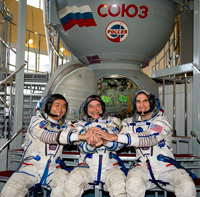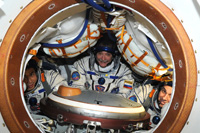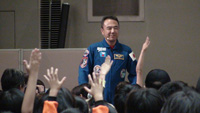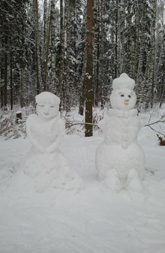Hello everyone. I didn't write my journal last month so it's been 2 months, hasn't it?
I am sure you know about the 16 day partial government shutdown in the US at the beginning of October. The cause was a confrontation between the political parties over the provisional budget and consequently, NASA was also shut down (apart from one part of operations). This was also an unusual situation for astronaut training which was suspended except for high priority tasks.
I mentioned one part of operations above but the continuation of tasks related to current missions, such as the operation of the International Space Station, were exceptionally authorised and fortunately, there were no adverse effects. At NASA, I am currently a Crew Support Astronaut so I was working as usual during this period and I was even busier than usual.
That was a long introduction but it is my excuse for not writing my column last month! This month I would like to write about Field Maintenance Training in which I was participating up until a few days ago. It is called Field Maintenance Training but it is probably closer to Aircraft Maintenance Training.
That was a long introduction but it is my excuse for not writing my column last month!
This month I would like to write about Field Maintenance Training in which I was participating up until a few days ago. It is called Field Maintenance Training but it is probably closer to Aircraft Maintenance Training.
The training was for 3 weeks from 28th October to 15th November at Ellington Air Force Base where we astronauts usually do aircraft operations training on the T-38 training jet.
NASA currently owns around 20 T-38s and this training was to conduct maintenance work on these along with professional mechanics. This is a very new type of training with the course that I attended only being a test run, the second of its kind, and it is still in the development stages as far as NASA is concerned.
So why is NASA trying to develop this type of training?
Currently, one of the main tasks that an astronaut conducts in orbit is the set-up and maintenance of ISS systems equipment and experimental devices. This is because even though most system control and scientific experiment implementations are possible by remote control from the ground, manual procedures by astronauts such as equipment installation and the replacement of experiment samples are required.
The skills required for these kinds of manual procedures are similar to the skills required by someone who does DIY. That is to say that you have to know the correct way to use the tools and you have to follow the procedures manual to accurately perform the procedure. However, the peculiarities of working in orbit are that there is a great number of different types of tools and that the number of spare parts is limited so there are not many possibilities if there is a problem, and so on.
These skills can be improved to a certain level by basically practising over and over but the DIY experiences of individual astronauts differ greatly and this is why, based on requests from astronauts who have experience of long-term missions on the ISS, we started the development of this kind of training with the aim of mitigating these differences even a little and raising skill levels.
At any rate, in the motorized society of America, there are many people who generally fix their cars in their own garages when there is a problem and there is a big difference between the people who have this kind of experience as opposed to those who don’t.
As for me, I have assembled a simple shelf before but I have only ever really used a screwdriver and a hammer ? the equivalent of an adventurer in level one of a video game. I hope to improve my experience even a little with a view to my future long-term mission to the ISS.
During the three weeks of training, we were on a rotation every few days to a different division in the T-38 maintenance department. I can just imagine the people reading this thinking, “Hey! Is it OK to let complete amateurs do maintenance on high-performance jets?”
In actual fact, when I was getting ready for this training, one of my senior astronauts, Akihiko Hoshide, gave me some heart-warming encouragement:“Good luck. Make sure you tell me which planes it was that you worked on (because I don’t want to fly on them).”
However, this is the world of aerospace in which safety comes first so there is an infallible system in place in which we are always with a qualified mechanic when we are training and the maintenance work that I did was, without fail, checked by that mechanic after I had finished and then double-checked by an expert called an inspector.
After starting the training, the first thing that I found to be a challenge was the large number of tools.
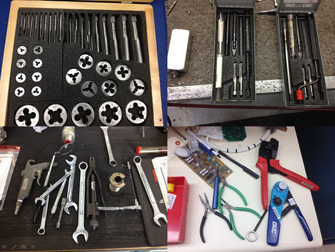
This photo shows only a “small” part of the tools that I used during training.
For a beginner like me, at first glance, there are a lot of tools that I wouldn’t know how to use. For example, for wrenches that tighten screws there are ratchet wrenches, combination wrenches, torque wrenches, etc. etc....
Not to mention that it is complicated because in America, the imperial system is still mainstream and we use inches as the unit for length and, worse, the inch is not divided decimally into units of 0.1 but into 1/32 or 1/16.
There are instructions such as, “Hey, put a 3 inch extension socket and a ? inch to 3/8 inch adapter on that ? inch ratchet wrench!” At first, even getting a picture of what tool they were talking about in my head was hard work.
NASA’s T-38 mechanics are all extremely experienced, each with over 20 years of experience. The senior mechanic who I worked with in the hydraulic systems division said he had been working at NASA for 32 years and that he had been in the air force for almost 20 years before that.
It is the same in all walks of life but experts like these are really incredible.
Just by looking at the head of a screw, they know right away whether it is a 7/16 inch screw or a 3/8 inch screw and, for example, when they are trying to tighten a bolt with one tool and it doesn’t work because there is a pipe in the way, they are able to immediately access tricky areas like this with a combination of certain tools. At any rate, they know all kinds of solutions to problems that occur and the speed with which they find the optimum solution for each case is no less than amazing.
I also learned how to deal with holes for screws that have deteriorated and how to remove bolts that have been attached too tightly.
These kinds of problems come up frequently in orbit so this training was really valuable to me.
The thing I had most difficulty with during this training was the attachment and removal of the air-conditioner on the T-38.
It all started with a case of a little bit of smoke in the cockpit. Judging from the situation, it seemed that smoke generated in the engine was coming out of the air-conditioner into the cockpit and finally, after having replaced some dubious parts and so on, it turned out that it was the air-conditioner itself that was dodgy and we replaced its central part.
The air-conditioner is in the centre of the lower portion of the fuselage. When you remove the panel, you can see an intricate system of pipes and cables. The central part that I was looking for is behind these, right at the back. I had to carefully and deliberately remove each pipe that had been artfully squeezed into such as small space.
Then, in the space we had created, the two of us had to cooperate to remove this large central part by periodically turning it. It had already taken us two hours to get to this point. I was thinking that it was just like a puzzle ring when, before I knew it, I said to the mechanic beside me, “I wonder if the guy who designed this thought about maintenance.”
He replied, “It’s like a jigsaw puzzle, isn’t it? People don’t come near me when I’m working on this kind of air-conditioner. They don’t want to get involved. But I must admit that I like working on it.”
I feel exactly the same way. Challenging tasks are much more worth doing and the sense of achievement once they have been completed is great.
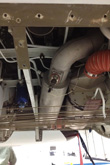
Air-conditioner storage area
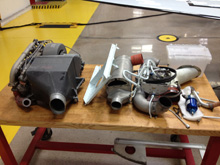
Removed air-conditioner parts
Luckily, we had a spare central part so we went ahead and installed it but this was much more difficult than the removal. This is because, instead of just loosening, removing and detaching, when installing each part must be properly returned to its original place or half-way through, you will come upon a pipe that you can’t connect.
Both me and the mechanic were dripping with sweat while working on this and by the time we got everything back in its original place and shut the panel, we were almost out of time for that day.
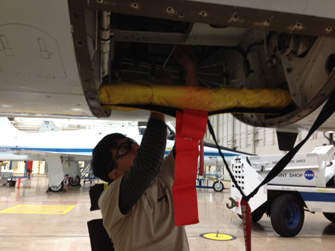
My struggle to install the air-conditioner
The next morning, we went straight ahead and tested the plane in which we had replaced the air-conditioner and there was no recurrence of smoke. I heartily shook the mechanic’s hand.
I learned many things during the three weeks of this training but the most precious thing may have been the time spent with people who had the thankless task of supporting us astronauts in our training.


Installing the panel on the fuselage
*Photo: JAXA/NASA
